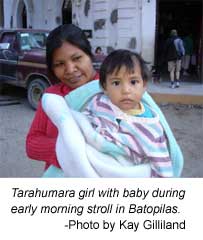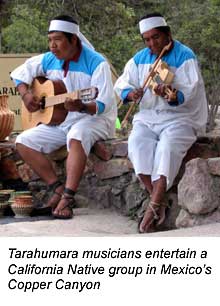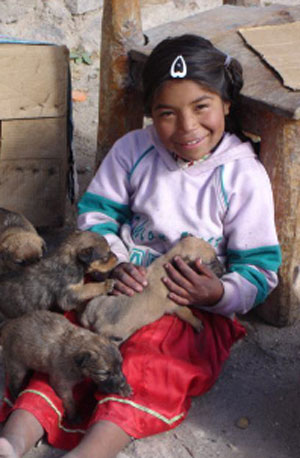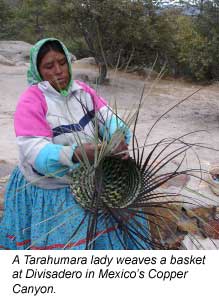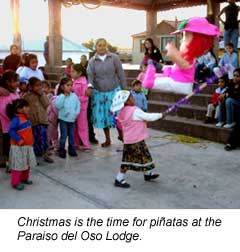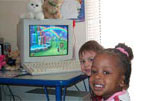Leaving Batopilas in Search of Cusarare Falls
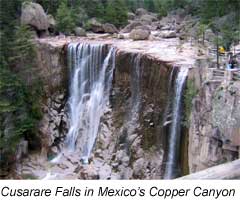
The following story was submitted to us by Kay Gilliland who describes her experience traveling with friends through Mexico’s Copper Canyon during the Christmas holidays. Today, the group leaves Batopilas and makes a stop at the majestic Cusarare Falls before returning to Creel.
The California Native is always thrilled to have groups of friends join our trips to this charming region of Mexico. We appreciate it when our guests share their stories with us and we like to add them to our blog for everyone to enjoy. Excerpts from her journal will be posted regularly, so check back often to learn more about Kay’s 11-day Copper Canyon Adventure.
December 30, Tuesday
Bags out early. Seven-thirty at Carolina’s for breakfast. There was good bread made by the proprietor of the General Store, eggs, freshly squeezed orange juice, and great fruit. We returned to Juanita’s Place, said goodbye, before Jenny and I started walking. We went into the church and a store and took pictures of people on the street.
Jessica caught up with us and we continued to the bridge. It was decided the tire needed air so Antonio took care of the vehicle in Batopilas while we walked on along the road. Antonio picked us up after having to take the tire off to check for leaks. It is 20 kilometers (more than 12 miles) uphill to La Buta and Jessica did that with a bicycle recently. Along that rutted, desolate-looking road, a man stood with his dog selling oranges.
We stopped at La Bufa and ate some of the oranges Jessica had purchased from the man at the side of the road.
We drove past the “U” in the road where I had walked on Sunday, gazed out at the curtain of rock and the “yurt” rock. We looked down to see the dirt road winding its way back to Batopilas.
We crossed a bridge where we looked down to see burros resting in the warm sand by the river. Next came Humira Point where we looked out at the canyon and bought things from local vendors. Much later we came to the paved road and clapped happily for Antonio who had maneuvered the long dirt road so capably. Little did we know there was more rough road to come.
Antonio soon turned onto on a dirt road and we were headed for Cascada Cusarare. Antonio crossed the boulder-filled stream five times. Jenny, Jessica and I got out to walk along the pine needle strewn trail, finally joining the others along the last half-mile of the trail to the cascade. We are such a disparate group that Jessica was running back and forth making sure each of us was okay, happy, and on the right path. All along the trail were Tarahumara families in beautiful, bright traditional clothing selling baskets, figurines, shawls, and other lovely things they had made. At the top of Cascada Cusarare the water fell in ribbons down to the stream far below.
When we reached the top Jenny had already hiked to the bottom of the falls 98 feet below so we took pictures of her down there. After walking back down the trail and buying a “snake” made from a root, I rode back out with Sally, Bill, Laurie, and Antonio.
Jenny and Jessica walked and we met them back at the paved road; they made it before we did. Soon we were back in Creel. Both museums were closed but the mission store was open, so, of course, we bought more mementos. I bought an offprint from the Annals of Sports Medicine entitled Rarajipari: The Kick-Ball Race of the Tarahumara Indians. At first I thought everything was very expensive, then I realized the prices were in pesos. Jessica explained that a share of the profits from the mission store goes to the Clinic of Santa Teresita, started by Jesuit priest Luis Verplancken in the 1950’s in an effort to improve the health the Tarahumara children. The clinic depends upon volunteers and provides services and medicines free to the Tarahumara and other people who need them. We walked across the street to supper—another delicious Mexican meal with Hibiscus juice and rice pudding for dessert. Back at The Lodge at Creel we were soon asleep.

